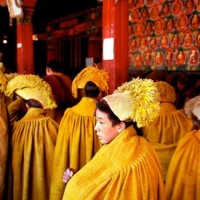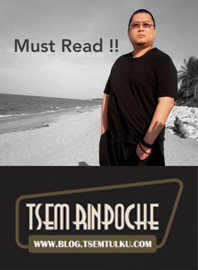
The Kadampa tradition founded by Atisha was the direct source of inspiration for the development of the Gelug tradition founded by Je Tsongkhapa (1357-1419). He was born in the Tsongkha region of Amdo province.
At the age of three he received full-fledged lay ordination from the Fourth Karmapa, Rolpey Dorjey, and the name Kunga Nyingpo. At the age of seven he received novice vows from his teacher, Chojey Dhondup Rinchen, and was given the name Lobsang Drakpa.
Even at this young age he had received many teachings and initiations of Heruka, Yamantaka and Hevajra, and could recite by heart texts like Expression of the Names of Manjushri.
Tsongkhapa travelled extensively in search of knowledge and studied with masters of all the existing traditions beginning with Chennga Chokyi Gyelpo, from whom he received teachings on topics such as the mind of enlightenment and the Great Seal(Mahamudra).
He was taught the medical treatises by Konchok Kyab at Drikung. In Nyethang Dewachen he studied the Ornament for clear Realisation and the Perfection of Wisdom and, excelling in debate, he became famous for his erudition.
He also travelled to Sakya where he studied monastic discipline, phenomenology, valid cognition, the Middle Way and Guhyasamaja with lamas such as Kazhipa Losel and Rendawa. He also received transmissions of the Six Doctrines of Naropa, the Kalachakra, Mahamudra, the Path and Its Fruit, Chakrasamvara and numerous others and transmitted them to his disciples.
In addition to his studies and teachings he engaged in extensive meditation retreats. The longest, at Wolkha Cholung, lasted four years during which he was accompanied by eight close disciples.
He is reputed to have performed millions of prostrations, mandala offerings and other forms of purification practice. Tsongkhapa frequently had visions of meditational deities and especially of Manjushri, with whom he could communicate to settle his questions about profound aspects of the teachings.
Tsongkhapa studied with more than a hundred teachers, practised extensively and taught thousands of disciples mainly in the central and eastern regions of Tibet. In addition he wrote a great deal. His collected works, comprising eighteen volumes, contain hundred of titles relating to all aspects of Buddhist teachings and clarify some of the most difficult topics of sutrayana and mantrayana teachings.
Major works among them are: the Great Exposition of the Stages of the Path (Lam-rim chen-mo), the Great Exposition of Tantras (sNgag-rim chen-mo), the Essence of Eloquence on the Interpretive and Definitive Teachings (Drang-nges legs-bshad snying-po), the Praise of Relativity (rTen-’brel bstod-pa), the Clear Exposition of the Five Stages of Guhyasamaja (gSang-’dus rim-Inga gsal-sgron) and the Golden Rosary (gSer-phreng).
Among his many main disciples, Gyeltsab Dharma Rinchen (1364-1432), Khedrub Geleg Pelsang (1385-1438), Gyalwa Gendun Drup (1391-1474), Jamyang Chojey Tashi Pelden (1379-1449), Jamchen Chojey Shakya Yeshe, Jey Sherab Sengey and Kunga Dhondup (1354-1435) are some of the more significant.
Tsongkhapa finally passed away at the age of sixty on the twenty-fifth of the tenth Tibetan month, entrusting his throne in Ganden to Gyeltsab-jey. So began a tradition which continues to the present day.
Of the major Gelugpa monasteries in Tibet, Ganden Monastery was founded by Tsongkhapa himself in 1409 and was divided into two colleges, Shartsey and Jangtsey. Jamyang Choje Tashi Pelden founded Drepung Monastery in 1416. At one time it had seven branches but these were later amalgated into four-Loseling, Gomang, Deyang and Ngagpa. Of only two colleges, Drepung and Gomang have survived up to the present time.
Another of Tsongkhapa’s spiritual sons, Jamchen Chojey Shakya Yeshi established Sera Monastery in 1419. This too initially had five colleges which were later amalgated into two-Sera-Jey and Sera-Mey.
Similarly, Gyalwa Gendun Drup, the First Dalai Lama, founded Tashi Lhunpo Monastery at Shigatse in 1447, which was to become the seat of the successive Panchen Lamas. It originally had four colleges.
The Lower Tantric College, Gyumey, was established by Jey Sherab Sengey in 1440, and the Upper Tantric College Gyuto by Gyuchen Kunga Dhondup in 1474. At their peak there were more than five thousand monks in each of the monastic universities around Lhasa, Ganden, Drepung and Sera, while there were at least five hundred in each tantric college.
Young men would travel from all three regions of Tibet to enroll at these monastic universities as monks in order to receive an education and spiritual training.
The Gelug tradition lays special emphasis on the place of ethics, as expressed through monastic discipline, as the ideal basis for religious education and practice. Consequently, the great majority of Gelugpa lamas are monks and the master who is a layman is a rarity.
In addition, the Gelug tradition regards sound scholarship as a prerequisite for constructive meditation, hence, the teachings of both sutra and tantra are subject to rigorous analysis through the medium of dialectical debate.
In general, the curriculum of study covers the five major topics-the perfection of wisdom, philosophy of the Middle Way, valid cognition, phenomenology and monastic discipline. These five are studied meticulously by the dialectical method using Indian texts as well as Indian and Tibetan commentaries to them, often textbooks unique to each monastic tradition, for a period of fifteen to twenty years.
On completing this training, a monk is awarded one of three levels of the degree of Geshey (Doctorate of Buddhist Philosophy), Dorampa, Tsogrampa and Lharampa, of which the highest is the Geshey Lharampa degree. Subsequently, if he so wishes the Geshey may join one of the tantric colleges to study the tantras and so complete his formal studies, or he may return to his local monastery to teach, or retire into seclusion to engage in intensive meditation.
A monk who has completed a Geshey’s training is respected as being a fully qualified and authoritative spiritual master worthy of devotion and esteem.
This tradition remains dynamic even after coming into exile. The major Gelug monasteries, Sera, Drepung, Ganden, and Tashi Lhunpo monasteries and Gyumey Tantric College have been re-established in various Tibetan settlements in Karnataka, and Gyuto Tantric College has been re-established in Bomdila, Arunachal Pradesh, all in India.
Source: Historical Introduction to the Five Principal Spiritual Traditions of Tibet








